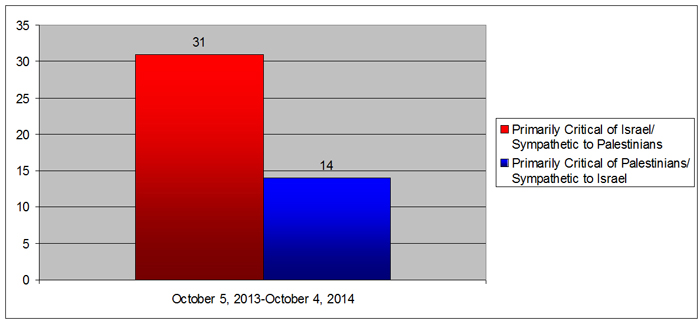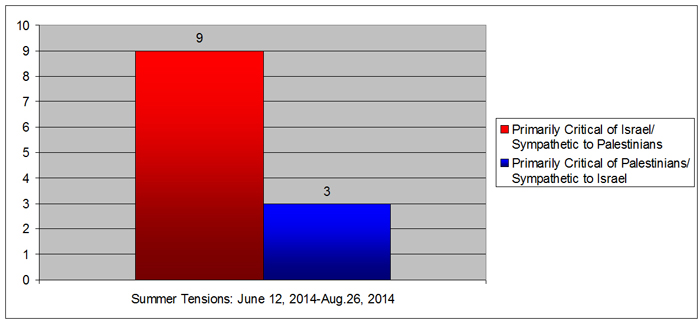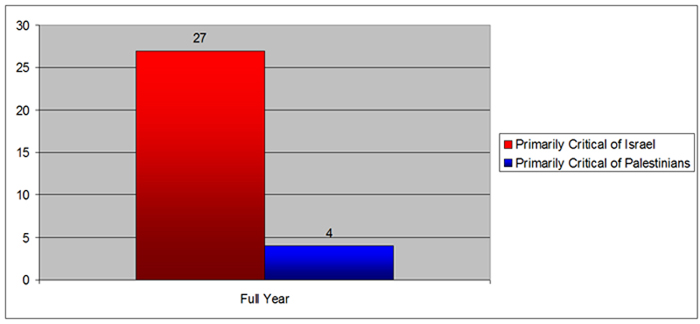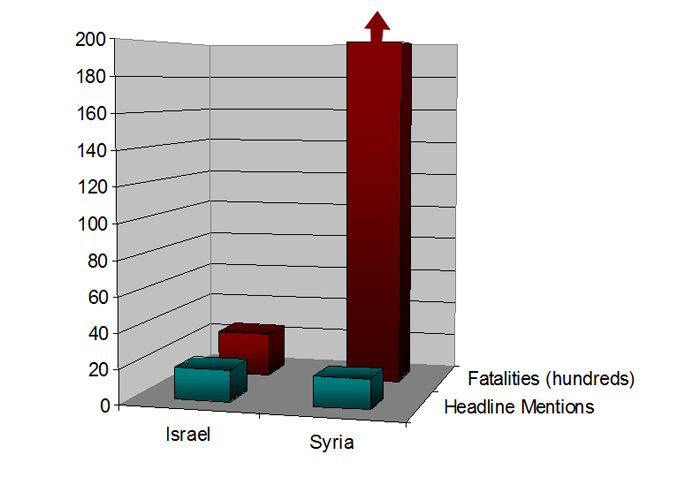The New York Times is nearly seven times more likely to publish pieces primarily critical of Israel than those primarily critical of the Palestinians, continuing a pattern of bias previously seen at the newspaper, a new CAMERA analysis has found.
The newspaper is also twice as likely to publish opinion pieces that predominantly support the Palestinian narrative about which side deserves more sympathy or criticism than pieces that predominantly support the Israeli narrative.


The discrepancy fits with the recent admission by a New York Times opinion editor that the newspaper chooses to shy away from scrutiny of Palestinians. Opinion editor Matt Seaton, who was commenting on Twitter about his department’s decision to publish three Op-Eds alleging Israeli racism in three consecutive months, asserted that The Times does not intend to publish pieces about Palestinian racism until the Palestinians have a “sovereign state.”
The newspaper practices what Seaton preaches. While a handful of pieces did convey sympathy about Israel’s challenges, the Palestinian side was largely shielded from the type of criticism often directed at Israel. Although 27 columns and Op-Eds focused predominantly on criticizing Israel, only 4 pieces focused predominantly on criticizing Palestinians. (Of the latter, three were focused on criticizing Hamas. Only one focused on criticism of the Palestinian Authority.)

And so throughout the year, readers were bombarded with negative messaging about one side of the conflict — a drum beat of over-the-top headlines about how “Israel Needs to Learn Some Manners,” “How Israel Silences Dissent,” “Israel’s Puppy, Tony Blair,” “Israel’s N.S.A. Scandal,” the “Lawless Holy Land,” the need to “Rein in Israel’s Rabbinate,” and “Bibi’s Big PR Stunt.” Under more subtle headlines, too, column after column slammed Israel. (Of the four articles focused on criticism of Palestinians, the two headlines that stood out were “To Save Gaza, Destroy Hamas” and “How Palestinian Hate Prevents Peace.”)
It is worth noting that the disproportion was nearly identical in pieces by columnists employed by The New York Times (for example Thomas Friedman and Roger Cohen) and in pieces by outside Op-Ed contributors. It’s also worth noting that this like-mindedness of columns and guest Op-Eds violates assurances made by the newspaper. The newspaper stated when the Op-Ed page was first introduced in 1970 that the new space would host writers whose views would “very frequently be completely divergent from our own.” Many years later, former Op-Ed editor David Shipley assured readers that the guideline still applied: “The Op-Ed editors tend to look for articles that cover subjects and make arguments that have not been articulated elsewhere in the editorial space,” he insisted (“And Now a Word From Op-Ed,” 2/1/2004).
Not so with Israel. Among pieces by staff columnists, thirteen were devoted primarily to criticizing Israel or sympathizing with Palestinians, while fewer than half as many, six, did the opposite. And editors saw to it that the Op-Ed pages were in lockstep. Among pieces by Op-Ed contributors, 18 primarily criticized Israel or sympathized with Palestinians, while (again) fewer than half as many, eight, focused on opposing views. In both sections, pieces focused on criticism of Palestinians were rare, with only one column and three Op-Eds doing so.
The newspaper’s obsession with Israel and the Palestinians overshadowed even the industrial-scale killing in Syria. While 75 opinion pieces focused on Israel or the Palestinians, 56 focused on Syria. And in many of the latter pieces, Syria was not the primary focus, as indicated by headlines “America Mustn’t Be Naïve About Iran,” “Saudi Arabia Will Go It Alone,” “Who Will Win in Iraq?,” “Iraq Must Not Come Apart,” “Why Arabs Fear a U.S.-Iran Détente,” “Fury in the Kingdom” (about Saudi Arabia), and “Have Patience with Us” (a request by the Iraqi leadership), and “A Middle Eastern Primer,” articles that were included in our count of 56 Syria-focused columns.
Headlines reflected the discrepancy. Over the course of the year, during which fewer than 2,500 people were killed in Israel, Gaza, and the West Bank, 18 headlines mentioned Israel. Syria was mentioned one time fewer, although about 20,000 people were killed there in just the 7-month period from March to September 2014, according to one organization’s calculations.

Earlier analyses by CAMERA found a similar bias. A 19-month study of guest Op-Eds in 2006-2007, using the same criteria as in this analysis, found that
the newspaper presented twice as many Op-Eds critical of Israel or espousing an Arab perspective as those supportive of Israel or critical of Arab policies. These included several columns by Arab leaders, including Fouad Siniora, prime minister of Lebanon, and Saeb Erekat, chief of the PLO Negotiations Department, as well as two columns by Ahmed Yousef of Hamas.
By contrast, there were no Op-Eds at all by any Israeli leader.
A 2011 study of New York Times editorials, columns, and Op-Eds also found an overwhelming disproportion favoring the Palestinians in the number of negative and positive opinion pieces about the sides and in the overall number of negative and positive passages about the sides.
1 Order vs. Disorder, Part 4
2 How Israel Silences Dissent
3 Israel’s N.S.A. Scandal
4 Israel Must Put Security First
and Bibi to Talk About
Mostly critical of Hamas behavior 12
Mostly critical of PA behavior
Mostly critical of Israel’s behavior 5 17 25 30 36 38 39 61 67 69 73
Mostly critical of Israelis’ behavior 37
Mostly critical of Palestinians’ behavior
Mostly sympathetic toward Palestinians
Mostly sympathetic toward PA 16
Mostly sympathetic toward Israel 18 32 41 58 63
Mostly critical of Hamas behavior 8 20
Mostly critical of PA behavior 74
Mostly critical of Israel’s behavior 3 24 29 31 33 35 50 51 53 54 56 57 60 72
Mostly critical of Israelis’ behavior 2
Mostly critical of Palestinians’ behavior
Mostly sympathetic toward Palestinians 6 14 22
Mostly sympathetic toward PA
Mostly sympathetic toward Israel 4 7 42 59 68
